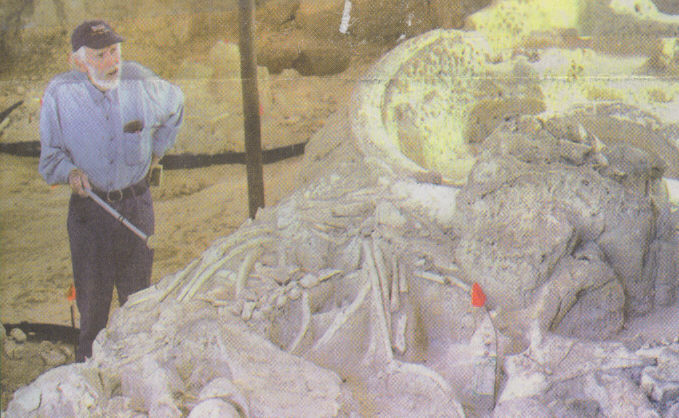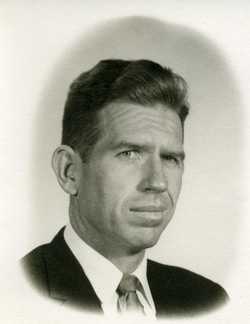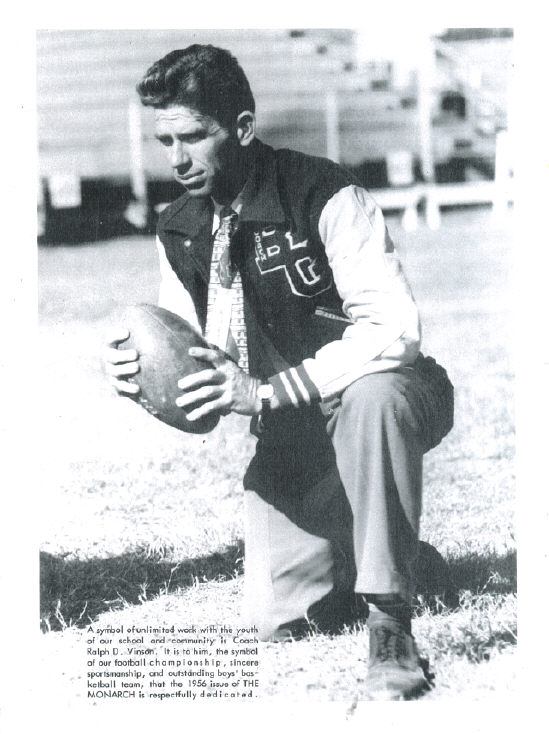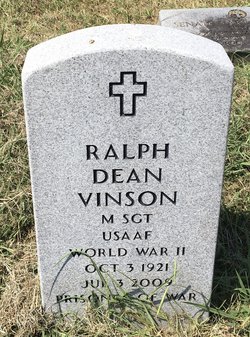|
Ralph Vinson came to
Blooming Grove, Texas from Coolidge, Texas in 1949 to be the football coach. He
coached in Blooming Grove for 16 years.
Ralph served in World War II and was a POW.
Diane Richards interviewed
him in 2005 about his capture. Ralph was an avid archeologist and
volunteered thousands of hours at the Waco Mammoth Excavation site. He
died on July 3, 2009. The Information provided here was submitted by
Diane Richards.
Five minutes over the Isen Banhoff and Danube River Bridges at Munich, Oct. 1944, Crew #17,765th Squadron of the 461st Bomb Group (Heavy) was awakened two hours before day break and began to carefully dress by candle light, filed into the mess tent for a quick breakfast, and hurried to the briefing room. The G-2 man (intelligence) announced that our target was Munich, Southern Germany. He had nothing to tell us other than our escape route was over the Alps Mountains to Switzerland. No fighters were expected, but he expected that many flak guns were probably moved from Ploerte to Munich since the Russians had driven the Germans out recently. He asked that we keep our eyes open for any information that he could use in the future. We grabbed our flying gear and paused at the chaplains alter and headed for the trucks. After the rough ride to the flight line, we arrived at our aircraft, while it was still dark. I was the engineer on our crew so with a flash light I began to preflight check every detail. Armorers were still loading bombs and removing the dollies. I began to check my machine guns and store the fifty caliber belts of ammunition. I hammer tightened the gasoline caps to keep them from sifening gas. On checking with the pilot, Lt. Waggoner, who was substituting for our regular pilot who was medically grounded temporarily, I discovered that I had forgotten to remove a pito-static tube cover that would make the plane impossible to fly in that condition, that made me worry and wonder how I could have made such a blunder. At last, I was ready and started the auxiliary power unit to begin starting our engines. We cranked up, warmed up, run up (full throttled) taxied out, the tower signaled “take off”, checked all stations for airborne ok, started at a low climb, and circled the field 5 times to close in to our formation, which meant that this was a big mission. Reaching 20,000 ft. altitude, we set the throttles open to 200 mph flat out northerly over the Alps Mountains now glistening with the sunlight on the ice and snow, but I had a vague feeling that things were not quite right from the very beginning. Some one in the nose deck began to have oxygen troubles. We had two “walk around bottles” that would last at least fifteen minutes so that was nothing to worry about. Some one cut in on the intercom saying “Let’s get the hell out of here.” Lt. Sharp, the co-pilot, said we are only five minutes from the initial point to start our bomb run, so we decided to stay the course and complete our mission. Turning at the I.P. to make the bomb run, we ran into heavy flak; shells were exploding in every direction at eye level, meaning that they had our range exactly. All we could do was to throw out packages of Christmas tree decorations (ice cycles made of silver), which we hoped would screen us from the sights of the gunners below. It seemed to help us a little bit. This barrage of flak was about a mile long and a hundred yards thick. Our bomb bay doors were open and we were taking damaging hits from flying shrapnel and was jolted by the explosions. Our lead aircraft began dropping down and falling back in a solid sheet of flames; as we passed over it I saw only three parachutes open when the whole plane blew apart in a blinding explosion; debris narrowly missing us. I could feel and see we were receiving more hits. One big round hole appeared on our right wing, which meant that we received a direct hit, but luckily did not explode. I saw part of our tail fin blown away and a big fist size hole appeared between me and the other waiste gunner and went through the other side. Our #3 engine began to smoke, but I quickly got that stopped. I was cowering behind my gun mount while “bombs away” and at this point there was a terrific jolting, metallic clank creating a strange feeling of pain and confusion. The next thing I knew we were in a steep glide and flames from #1 engine were licking in the waiste window. The bomb bay doors were damaged and flapping in the slip stream. The cat walk was broken and unsteady. We got the fire out. My first concern was to get ready for the German fighters because we were now a lone cripple. Assessing the damage to two engines etc., I noticed my ears were popping (meaning a quick change in altitude). I called the pilot for an altitude check. He said below 11,000 ft. We were hit at 27,000 feet. I flew into a sort of rage and said forget flying to Switzerland, we have got to bail out. At this time Lt. Sharp, the co-pilot, said in a very weak voice “I can’t bail out!” I started preparing a static line so we could throw him out and open his parachute. Lt. Waggoner, the pilot said “Any of you who want to go it alone have my permission to bail out, but if I can find a level field big enough, I think I can set her down.” At this time, we ceased to be a combat unit and became a survival unit. Lt. Brenia, the navigator, broke in and said to not fly over the lake ahead, but too late as small arms fire began that sounded like some one throwing hands full of gravel at us. We quickly turned to the right and lowered our landing gear and the bullets stopped. I assisted everyone out of the nose and through the damaged bomb bay to crash stations. We hit the ground very hard, bouncing first on the left wheel then on the right wheel before rolling to a stop. At this point I had never given a thought to surrendering. I had not a clue as to what to do. I could wave my white scarf out the window before I left or jump out and make a run for it. I deliberately climbed out and stood on the ground, when I saw a young looking man approaching me on a bicycle. I thought I could take him with my side arm. Then, I heard a noise from another direction which was a half track armored vehicle with turret mounted machine guns bearing down on me. My hands went immediately up. The bicycle rider decided to get his gun out, nervously, pointed it between my eyes and shouted “American boy, for you the war is over.” A major or colonel stepped down from his staff car and took over from the “shave-tail.” He asked me what was wrong with #1 engine. I replied, “I guess flak hit it. He swung on me and said “You sabotaged it, you son of a bitch.” I wished I had done more damage. I tried to tell the major we had a wounded man aboard. He said he knew some English, but he could not understand American talk. I called up my tail gunner who was a French Canadian from New Hampshire to see if the German could talk French. They began to “parley-vou” and Turgen said he would not send his man into our plane and he would not permit us to go back into the plane. “Tell him to send one of his men and one of our men in together to which he agreed, so Lt. Norman Sharp, co-pilot, on #39 Liberator was carried out on a blanket in unconsciousness of comatose condition and laid on the bare ground. He cried out in pain once. He died in a German hospital Oct. 7, 1944. We were transported by truck to the Landenburg city jail where we were presented like trophies to all the local officials as evidence that they were winning the war and were congratulated for the capture of a real live Liberator Crew on their watch. After processing and being sent to a permanent P.O.W. camp, Stalag Luft IV, a prison for enlisted airmen. We spent seven months at this camp and were treated a little less than humans waiting to be liberated by someone else.
"Ralph Vinson stands beside some of the unearthed mammoth bones. Part of an article in the
Waco Tribune "A MAMMOTH undertaking"
RALPH D. VINSON
Notes:
Funeral Home info: Facts
Ralph Vinson while coaching at Blooming Grove TX High School
|

 Ralph
D. Vinson, 87, of Whitney and formerly of Waco and Blooming Grove passed
away Friday, July 3, 2009 at his home. Funeral services were held at 2
p.m. on Tuesday, July 7, at Wade Funeral Chapel in Hubbard with Rev.
Bill Mayfield officiating. Interment will follow with military honors
followed in Collidge Cemetery.
Ralph
D. Vinson, 87, of Whitney and formerly of Waco and Blooming Grove passed
away Friday, July 3, 2009 at his home. Funeral services were held at 2
p.m. on Tuesday, July 7, at Wade Funeral Chapel in Hubbard with Rev.
Bill Mayfield officiating. Interment will follow with military honors
followed in Collidge Cemetery.
